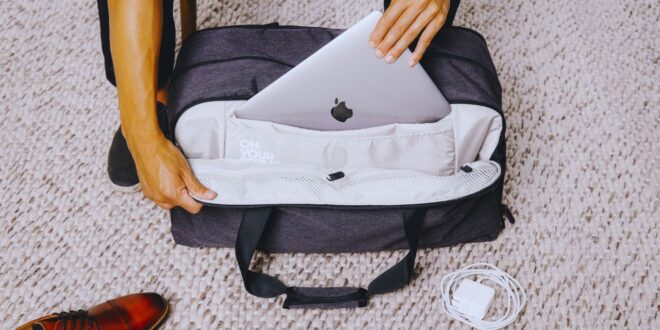Introduction: The Concerns of Traveling with Electronics
In today’s digital age, electronic devices have become indispensable, especially when traveling. Laptops, in particular, serve as essential tools for work, entertainment, and staying connected. Whether embarking on a long-haul flight, navigating a multi-stop itinerary, or simply managing the logistics of travel, the convenience of having a laptop readily available cannot be understated.
However, this convenience also brings about certain dilemmas. One pressing concern for many travelers is whether to place their laptops in checked luggage. This scenario often arises during lengthy trips where carry-on space is limited, or when travelers wish to avoid the hassle of carrying heavy electronics through airport security and during layovers. Additionally, certain airlines impose restrictions on the size and weight of carry-on items, further prompting the consideration of checked baggage for laptops.
The decision to place a laptop in checked luggage is not one to be taken lightly. The potential risks involved range from physical damage due to rough handling of luggage to the possibility of theft or loss. Moreover, the sensitive nature of electronic devices makes them vulnerable to extreme temperatures and pressure changes in the cargo hold, which could adversely affect their functionality.
Given these factors, it becomes crucial to weigh the pros and cons of placing a laptop in checked luggage. The subsequent sections of this blog will delve deeper into the safety concerns, provide expert recommendations, and suggest best practices for those who find themselves needing to make this decision. Understanding the implications and taking informed steps can help mitigate risks and ensure that your electronic devices remain safe and functional throughout your travels.
Airline Regulations and Policies
When considering whether it is safe to place your laptop in checked luggage, it is crucial to understand the airline regulations and policies governing the transport of electronics. Major aviation authorities, including the Transportation Security Administration (TSA) and the Federal Aviation Administration (FAA), have established guidelines to ensure the safety of passengers and their belongings during air travel.
Most airlines follow the TSA and FAA recommendations, which advise passengers to carry their electronic devices, such as laptops, in their carry-on baggage. This recommendation stems from concerns over the risks associated with lithium-ion batteries, which are prevalent in modern laptops. These batteries can pose a fire hazard if damaged, and having them in the cabin allows the flight crew to address any issues promptly.
Some airlines have strict policies that outright prohibit laptops in checked luggage. For instance, carriers like American Airlines and Delta Airlines have clear guidelines stating that laptops should be transported in carry-on bags. This policy is not just for safety but also to protect passengers’ valuable electronics from potential damage or theft that could occur in the baggage handling process.
The rationale behind these regulations extends beyond fire hazards. Electronic devices are susceptible to damage from rough handling or extreme temperatures in the cargo hold. Additionally, the risk of theft is higher in checked baggage, as access to these items is less controlled compared to carry-on luggage.
In summary, while airline regulations and policies may vary, the consensus among major airlines and aviation authorities is clear: it is safer and more prudent to carry your laptop in your carry-on luggage. This practice not only mitigates potential fire hazards but also protects your valuable electronics from damage or theft.
Risks of Physical Damage
When considering whether to place your laptop in checked luggage, it’s crucial to understand the significant risks of physical damage associated with this decision. Checked baggage undergoes rough handling during various stages of transit, including loading and unloading from the aircraft, which can result in severe impacts. Baggage handlers often work under time constraints, leading to quick, sometimes forceful movements of luggage. This rough handling can cause a laptop to sustain damage such as cracked screens, broken hinges, or even internal component failures.
Baggage stacking is another factor contributing to the risk of physical damage. In the cargo hold, luggage is often stacked on top of each other, subjecting your laptop to substantial pressure. The weight of other bags can easily cause structural damage to a laptop, particularly if it is not adequately cushioned or packed within hard-shell luggage. Even with a protective case, the cumulative pressure from multiple bags can lead to permanent damage.
Turbulent flights further exacerbate these risks. During turbulence, the contents of the cargo hold can shift abruptly, causing additional stress on the baggage and its contents. This movement can lead to laptops being jostled around, increasing the likelihood of physical damage. Real-life examples highlight these risks; numerous travelers have reported arriving at their destinations only to find their laptops damaged beyond repair due to the harsh conditions in the cargo hold.
Statistics also underscore the prevalence of this issue. According to a report by the U.S. Department of Transportation, thousands of electronic devices are damaged in checked baggage every year. This data emphasizes the inherent risks of placing valuable and sensitive electronics like laptops in checked luggage. While airlines may compensate for damaged items, the process can be time-consuming and may not cover the full value or extent of the damage.
Security Concerns: Theft and Tampering
When considering whether it is safe to put your laptop in checked luggage, security concerns such as theft and tampering are paramount. The inherently less secure nature of checked baggage compared to carry-on items makes it a target for unauthorized access. Security protocols at airports are designed to protect passengers, but the high volume of luggage handled daily creates opportunities for theft and tampering.
According to the Transportation Security Administration (TSA), incidents of theft from checked luggage, while not rampant, do occur. A study by SITA in 2019 revealed that approximately 7.3 bags per thousand passengers were mishandled, which includes theft and loss. Electronics, particularly high-value items like laptops, are especially attractive to thieves due to their resale value and the sensitive data they may contain.
There have been numerous anecdotes from travelers who have experienced theft or tampering with their checked luggage. For instance, a passenger traveling from New York to Los Angeles reported that their laptop was missing when they retrieved their luggage at the destination. In another case, a traveler found their laptop case tampered with and the device damaged, leading to significant inconvenience and financial loss.
To mitigate these risks, several measures can be taken. First, using TSA-approved locks on your checked luggage can deter casual thieves. While these locks can be opened by TSA agents, they provide an additional layer of security against unauthorized access. Second, consider placing your laptop in a hard-shell case within your luggage to protect it from physical tampering. Additionally, investing in a tracking device can help locate your laptop in the event it is stolen. Devices such as Apple’s AirTag or Tile can be discreetly placed in your laptop case, allowing you to track its location via a smartphone app.
Ultimately, while there are steps you can take to reduce the risk, the safest approach remains to carry your laptop with you in your carry-on luggage whenever possible. This ensures you retain control and oversight of your valuable device throughout your journey.
Battery Hazards and Fire Risks
Lithium-ion batteries, which are ubiquitous in modern laptops, present significant hazards when it comes to airline travel. These batteries, while efficient and compact, are also volatile. If damaged, they can become a serious fire risk, as they are prone to overheating and, in extreme cases, catching fire. This risk is exacerbated when batteries are packed in checked luggage, where they are subjected to less controlled environments and handling.
Incidents involving battery fires on aircraft have been documented, underscoring the potential dangers. Such fires can be catastrophic, given the confined space and limited firefighting resources available onboard. For instance, the Federal Aviation Administration (FAA) has recorded numerous instances where lithium-ion batteries have ignited in cargo holds, leading to severe safety concerns.
To mitigate these risks, aviation authorities have issued strict guidelines. The FAA, for example, recommends that passengers carry lithium-ion batteries in their carry-on luggage where cabin crew can quickly address any issues. Batteries should be kept in their original packaging, or in a protective case, to prevent short circuits. Additionally, passengers are advised to turn off laptops and other electronic devices to minimize the risk of accidental activation or overheating.
Moreover, international aviation organizations, such as the International Air Transport Association (IATA), have established protocols for the safe transport of lithium-ion batteries. These include prohibiting damaged or recalled batteries from being transported and limiting the watt-hour rating of batteries that passengers can carry. Such measures are essential to ensuring that battery-related incidents are minimized, thereby protecting both passengers and crew.
Understanding the hazards associated with lithium-ion batteries and adhering to recommended safety measures is crucial for safe air travel. By following these guidelines, travelers can help prevent potential fire risks and contribute to overall flight safety.
Insurance and Liability Issues
When considering whether to place a laptop in checked luggage, understanding the insurance and liability implications is crucial. Airlines generally have limited liability for loss or damage to checked luggage, and this limitation often extends to electronic devices such as laptops. The Montreal Convention, which governs international air travel, caps the compensation for lost or damaged baggage at approximately $1,600, but this amount may not cover the full value of a high-end laptop.
Moreover, airlines typically exclude liability for fragile, valuable, or perishable items that are placed in checked luggage. This means that even if your laptop is damaged or lost, the airline might not be responsible for compensating you, placing the financial burden on the traveler. Therefore, it is advisable to check the specific terms and conditions of the airline you are flying with to understand their policies regarding electronic devices in checked luggage.
To mitigate these risks, travelers should consider purchasing travel insurance that includes coverage for electronic devices. Such policies can provide additional protection beyond the limited liability offered by airlines. When selecting travel insurance, ensure that the coverage limit is sufficient to cover the full value of your laptop and other electronics. Additionally, verify the specific terms related to theft, accidental damage, and loss, as these can vary between insurance providers.
It is also prudent to document your electronic devices before traveling. Take photographs and keep receipts or proof of purchase, as these can support any claims you may need to file. Some travel insurance policies may also require you to report the loss or damage to the airline and obtain a written report before submitting a claim.
Overall, understanding the insurance and liability issues associated with putting a laptop in checked luggage can help travelers make informed decisions and take necessary precautions to protect their valuable electronic devices during air travel.
Alternatives to Checking Your Laptop
Traveling with a laptop can be essential for both business and personal reasons. However, placing it in checked luggage poses significant risks, including potential damage, theft, and loss. Fortunately, several alternatives can help ensure your laptop’s safety during your journey.
One of the most straightforward and effective alternatives is carrying your laptop in a carry-on bag. By doing so, you maintain constant oversight and reduce the risk of damage or theft. Airlines generally allow for a personal item in addition to a carry-on, so this option is feasible for most travelers. Moreover, having your laptop easily accessible can be particularly advantageous during layovers or while waiting at the gate, allowing you to continue working or staying entertained.
Using protective cases or sleeves is another practical measure. These accessories offer an added layer of protection against physical damage. A high-quality laptop sleeve or hard-shell case can absorb shocks and prevent scratches, keeping your device in pristine condition. Many travelers have attested to the effectiveness of these protective measures. For instance, Sarah, a frequent flyer, recalls how her sturdy laptop sleeve prevented any damage during a turbulent flight.
Additionally, some travelers recommend utilizing specialized electronics backpacks. These backpacks often come with padded compartments specifically designed for laptops, offering both protection and ease of access. For example, Tom, a business consultant, found that his electronics backpack not only kept his laptop safe but also organized his cables and accessories efficiently.
Another tip is to remove any valuable data from your laptop before traveling. By backing up important files to an external drive or cloud storage, you mitigate the risk of data loss in case the laptop is damaged or stolen. Many travelers have found peace of mind knowing their critical information is securely backed up.
Incorporating these alternatives into your travel routine can significantly enhance the safety of your laptop. Whether through carrying it in a carry-on, using protective gear, or taking additional data precautions, these methods have proven effective for numerous travelers. By adopting these practices, you can travel confidently, knowing that your laptop is well-protected.
Conclusion: Weighing the Risks and Making an Informed Decision
In light of the information discussed, it is evident that putting a laptop in checked luggage carries considerable risks. From potential physical damage and theft to the possibility of data loss and privacy breaches, travelers must weigh these factors carefully. Airlines’ varying policies and security measures further complicate the decision, making it crucial for travelers to stay informed and prepared.
Travelers should consider the specific circumstances of their journey. For instance, if your flight involves multiple transfers or extended layovers, the risk of mishandling or theft increases. On the other hand, if you are traveling for business and need immediate access to your laptop upon arrival, carrying it in your hand luggage might be the more prudent choice. Additionally, investing in robust protective cases and ensuring your device is password-protected can mitigate some risks.
Insurance options can also play a significant role in your decision-making process. Comprehensive travel insurance that covers electronics can provide peace of mind, though it’s essential to read the fine print to understand the extent of coverage. Backing up important data before travel is another critical step to safeguard against loss.
Ultimately, the decision to place your laptop in checked luggage should be based on a thorough assessment of the potential risks and benefits. By staying informed and taking proactive measures, you can make a choice that aligns with your travel needs and personal preferences. Whether you opt for the convenience of checked luggage or the security of carrying your laptop on board, being prepared and cautious will help ensure a smoother travel experience.
 Travelers Journey Hub
Travelers Journey Hub




